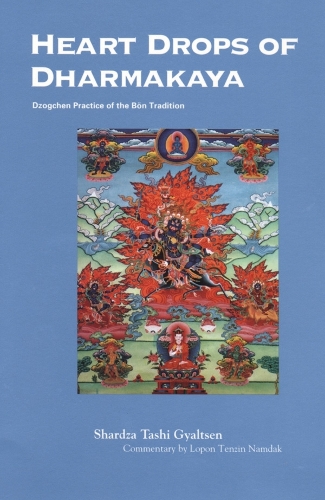
Heart Drops of Dharmakaya: Dzogchen Practice of the Bon Tradition
(Paperback)
Publishing Details
Heart Drops of Dharmakaya: Dzogchen Practice of the Bon Tradition
By (Author) Shardza Tashi Gyaltsen
Translated by Yongdzin Lopon Tenzi Namdak
Commentaries by Yongdzin Lopon Tenzi Namdak
Edited by Richard Dixey
Introduction by Per Kvaerne
Shambhala Publications Inc
Snow Lion Publications
15th February 2013
United States
Classifications
General
Non Fiction
East Asian religions and spiritual beliefs
299.54
Physical Properties
Paperback
200
Width 140mm, Height 216mm, Spine 14mm
289g
Description
This book presents a complete Dzogchen meditation manual from the ancient religious tradition of Tibet known as Bon. The Kunzang Nying-tig by Shardza Tashi Gyaltsen is a powerful and practical instructional text which cuts to the heart of Dzogchen meditation. Dzogchen is regarded by Bonpos as the highest and most esoteric religious practice. Written in the style of personal instruction from Shardza to his students the manual is supplemented with a commentary by Lopon Tenzin Namdak, who is himself an ackowledged master of Dzogchen. The translation was carried out by Lopon in the course of teaching the text to Western students at his monastery in the Kathmandu valley.
Reviews
"This is one of the most important books in Dzogchen as demonstrated by the author Shardza Tashi Gyaltsen who attained the rainbow body. My kind root master Lopon Rinpoche's clear and direct commentary elucidates all the major points of this essential text." Geshe Tenzin Wangyal Rinpoche, author of Tibetan Yogas of Dream & Sleep
"For most readers this book will serve as the first "insider" introduction to Bn, the indigenous spiritual tradition of Tibet. . . . We have in Heart Drops an inspiring text that no doubt will help to vindicate Bn as an indispensable source of Dzogchen teachings." Tricycle: The Buddhist Review
"Written in the direct, personal, and meaningful style of instructor to student . . . enthusiastically recommended reading." Wisconsin Bookwatch
Author Bio
Shardza Tashi Gyaltsen (1859-1935) was born in the Kham region of Tibet. An unusually gifted child, he became a monk at age nine. At thirty-four he retired to a mountain hermitage where he passed the rest of his life in retreat, meditating, writing, and teaching students from both Buddhist and Bonpo backgrounds.
